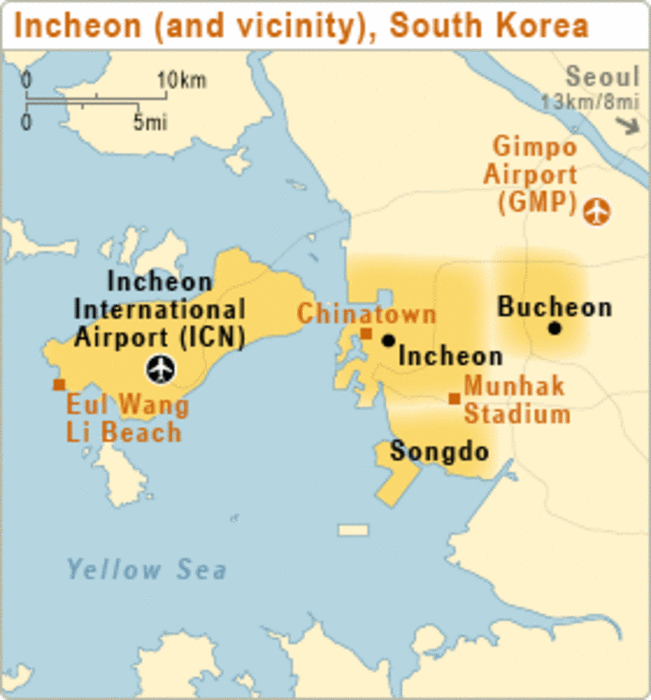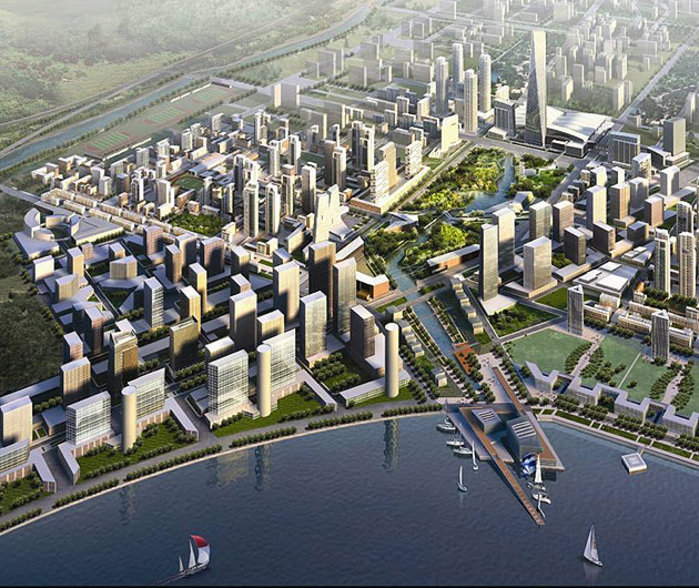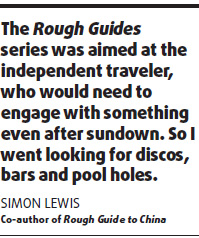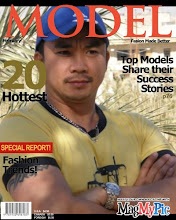David McNeill in Seoul
Take a man-made island, roughly the size of London’s Hampstead Heath. Fill it with state-of-the-art schools, hospitals, apartments, office buildings and high-end cultural amenities. Import architectural features from around the world, including New York’s Central Park and Venice’s canals, make English the lingua franca, and hang a sign at the gates that says: “Open for business.”
Attempting a mammoth project like that would be a risky venture in the best of times, let alone in the middle of Asia’s worst business slump since the 1970s. Putting it mostly in the hands of a single largely untested US firm and financing it with recycled real-estate profits sounds like an act of lunacy. Yet this is what is what is happening in South Korea, and strangest of all, it appears to be working.
Built on 1,500 acres of land reclaimed from the Yellow Sea off Incheon, about 35 miles West of the South’s capital Seoul, New Songdo City is billed as the largest private real-estate development in history – Korea’s answer to Shanghai and Dubai. Five years ago it barely even existed on a map.
Songdo and Incheon
By 2015, when it is due for completion, Korea says this speck of strategically placed foggy flatland will be the world’s gateway to Northeast Asia -- a free economic zone with eighty thousand apartments, fifty million square feet of office space and ten million square feet of retail.
Songdo rising from the mud flats
That only scratches the shiny surface of Songdo’s ambition. The city aims to do nothing less than banish the problems created by modern urban life. Asian business capitals, say the city’s publicity blurbs, are “racked” by environmental damage, undereducated workforces and a lack of available space. “It would seem a city that enjoys clean air…and a superior quality of life just doesn’t exist anymore.” Sondgo solves that problem by building from the ground up, providing “everything one could possibly want, need and dream of in a world-class city.”
So forget Asia’s choking metropolises, forty percent of Songdo is officially designated “green,” including the centerpiece 100-acre park. The city’s main car depot has been buried in a sunken courtyard to keep heat and emissions down. A sleek new public transport system including underground trains linked to Seoul and a network of electric water taxis in the city’s salt-water canals will help make this one of the cleanest urban areas on the planet. Ironically, perhaps, protests about the city’s environmental impact on internationally important tidal-flats have dogged – though not derailed – its construction.
It all sounds too good to be true, and perhaps it is. But for now, New York-based real estate company Gale International, in (70-30) partnership with Korean steelmaking and construction giant Posco, is having little trouble selling the dream. Songdo’s first block of 2,600 apartments was oversubscribed by about 8-1 when it went up for grabs in 2006. Another 1,000 will come onto the market this year and despite the sour economic data pouring out of Asia, Gale sees little difficulty in offloading them.
Gale’s Elliptical Plaza.
“Koreans believe in this project,” says British-born David G. Moore of Gale’s project management team. “They view this as an investment in the future.” Others apparently agree: Sheraton opened a new 319-bedroom hotel in August, golfing legend Jack Nicklaus is overseeing the construction of an 18-hole 7,300 yard championship course; and in April this year, US tech multinational Cisco Systems signed a multi-billion dollar deal to provide network technologies to the new city.
Daniel Liebeskind’s Riverstone at the heart of Songdo’s commercial and retail area
Like most grandiose schemes, Songdo is suspended on a billowy featherbed of confidence, and debt. Gale has gone billions into the red to build its state-of-the-art showcase. The 65-floor Northeast Asia Trade Tower, which will be Korea’s tallest building when complete, has been refinanced, despite the fact that main lender Shinhan Bank, in the words of one insider, “shuddered” when the global economic crisis hit Korea last year.
Rumors that the project could be in trouble, unable to secure loans from banks that have grown newly stingy, forced Incheon’s famously gung-ho Mayor Ahn Sang-soo on the defensive in the summer. “The current global economic crisis won't deter us,” he said. With global investors becoming more selective, Mayor Ahn and Gale assert that Sondgo will shine even brighter among the charred wreckage of failed real-estate ventures. “It’s different from any other project because we’ve maintained real quality,” says Moore. “That’s why people are still buying into it.”
Few doubt the quality of the architecture and construction. Most components of the city, from the 470,000 square-foot International School to Songdo’s $155-million Convention Center, which opened last October, are state of the art. The glittering campus of the school, affiliated with the prestigious US-based Milton Academy, has facilities to rival most universities, including a 650-seat theatre and a TV studio in the basement connected to the Internet that will allow its young students to broadcast around the planet (link). “They’ve spared nothing,” says the school’s head Jorge Nelson. “It is probably the most advanced school in the world.”
Wall of praise at the International School
Most advanced school in the world . . . with construction to date estimated to have cost $150 million. However, South Korea’s Ministry of Education in July rejected the school’s application to open this fall, stating that it failed to meet nine of the ten criteria for running a school. Parents who moved to Songdo will have to make other arrangements for their children this year.
Computers will be built into the houses, streets and offices as part of a “ubiquitous” network linking everyone in a sort of digital commune that is expected to be a high-tech technological showcase – despite privacy concerns. Lead architect, US firm Kohn Pedersen Fox calls it “the project of a lifetime.” The firm’s head James von Klemperer told Architectural Record earlier this year that it boasted “everything. “That includes culture, health, education, commerce, and recreation.” After decades struggling in the shadows of giant neighbors Japan and rising China, Korea believes the world will now come to it.
“You know, by the middle of this century, this region (East Asia) will produce 40 percent of the world’s GPD,” says Hee Yhon Song, chairman of the Asia Development Institute. Mr. Song says South Korea's central geographical position — Seoul is a two-hour flight from Beijing and Tokyo — along with its size, mature economy, and Western-educated elite, give it advantages few in the region can match. "I believe we are unique," he says.
Still, many wonder if the mostly privately financed project, variously estimated at $20 - $40 billion, will continue to defy economic gravity. An earlier blueprint crashed and burned after the 1997/8 financial crisis before Incheon was reborn as a free economic zone in 2001. But the venture has the crucial backing of the South Korean government, which is underwriting the city’s infrastructure, including the high-speed rail system that will ferry people to and from Seoul, and the newly built (2001) Incheon International Airport. A 12.3-km bridge linking the airport to Songdo is almost complete. That rock-solid state guarantee has helped banish concerns that the entire program is built on swampy ground.
Incheon Bridge connecting Songdo to the International Airport
Incheon has sold off parcels of land at premium prices to Gale, Posco and other developers, attracting $9 billion in foreign investment since the first brick was laid in 2004, and perhaps four times that amount in promises, according to The Korea Herald. The developers must keep shifting retail space and other real estate or the whole process grinds to a halt. The first post-recession test comes this year when more apartments come up for sale.
Songdo is the latest, and one of the most spectacular examples of what urban theorist Mike Davis calls “imagineered urbanism,” – global cities, sometimes built from scratch, where “all the arduous intermediate stages of commercial evolution have been telescoped or short-circuited to embrace the ‘perfected’ synthesis of shopping, entertainment and architectural spectacle.” Asia, particularly China, is the locus for many of these projects.
In the Meixi Lake District in central China’s Hunan Province, Dale plans another 1,675-acre state-of-the-art green city, with high-tech offices, apartments, schools, malls, five-star hotel, and a world-class convention center, “all set within an integrated, people-friendly lake environment and surrounded by abundant green space.” Like Songdo, Meixi is backed by the state - Changsha Municipal Government.
Then there is Dubai in the United Arab Emirates, the planet’s largest building site, after Shanghai, complete with the world’s biggest shopping mall, theme park, airport, artificial island, and a 7-star hotel offering rooms at $5,000 per night. Fuelled – at least until the global financial crash – on a high-octane cocktail of oil money, cheap labor and architectural gigantism, critics say Dubai is an ecological folly. Davis contemptuously calls it [Albert] “Speer meets Disney on the shores of Araby.”
The cities are, in effect, gated communities, bounded by high walls of cash that bar access to the poor. An average apartment in Songdo costs $500,000, with some going for twice or three times that. Fees at the International School start at $25,000 a year. Even shopping at the 100,000-square-foot Taubman Shopping Center will be out of the range of many ordinary Koreans, admit the developers.
Will it succeed? The history of purpose-built cities like Brasilia, Islamabad and Canberra, as opposed to those that have grown organically, is not encouraging. Songdo risks becoming a sterile urban theme park, warn some observers. “If you live in Manhattan, why would you want to live in a new town in Long Island or somewhere like that?” wonders Mo Jongryn, a professor at Seoul’s Yonsei University.
Songdo’s planners counter that it is unique, offering a mix of business, educational and leisure facilities that will convince skeptics and attract Korea’s share of the global, English-speaking techno-elite. The center’s centerpiece is the Global University Campus, a collaborative attempt to blend Korean, European and American academic strengths. At least two US colleges - the State University of New York at Stony Brook and North Carolina State University - have signed up to the project and another three are in line.
The model is similar to Qatar’s Education City, in which American (and British) universities will offer undergraduate programs inside a single campus, while administering them separately. Songdo’s Global Campus will eventually bypass the academic shortcomings of Korea’s mostly moribund colleges, incubate world-beating research and seed spin-off businesses, says Song. “I believe that without this university the Songdo project will not succeed.”
Not everybody is so enthusiastic. Academics at other universities, including Yonsei, say they have been shoehorned into moving to Sondgo thanks to sweetheart deals with the Incheon government. “Nobody on the Yonsei campus wants to move to Incheon,” claims Horace Underwood, a professor emeritus at Yonsei.
“Every department and organization is fighting against it. “ He says the attempt to move the university’s international program to Songdo will “destroy” them. “When an international student (typically Korean-American) has to choose between Yonsei at Incheon and a Korea University program in Seoul, that student will go to the campus in the city.”
But problems or not, Songdo will keep going, Mo insists. “The government is in a big bind, and can’t pull out of the project. Once you start something this big it is unstoppable. Billions have been invested. If you stop at one-third, the money is lost and the people who are already there will be angry. You have to go all the way.”








